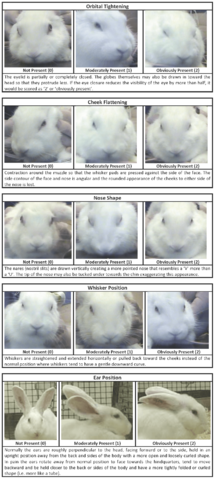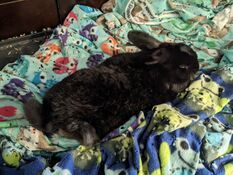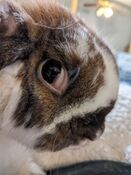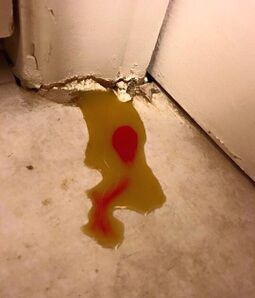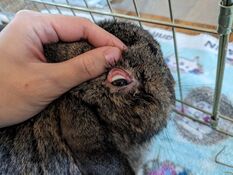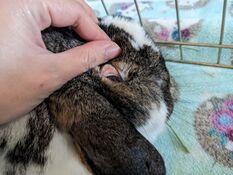Veterinary emergencies

Because rabbits are prey animals, they work very hard to hide any signs of illness. As a result, owners often cannot tell when a rabbit is sick until severe symptoms have appeared. Daily interaction with your bunny will help you realize what is normal and irregular.
Common symptoms
If your rabbit shows any of the following symptoms, make an appointment with your rabbit-experienced veterinarian as soon as possible or even an emergency veterinary clinic depending on the symptoms. Seemingly minor symptoms can escalate quickly and turn into major emergencies within 24 hours.
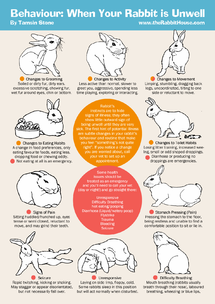
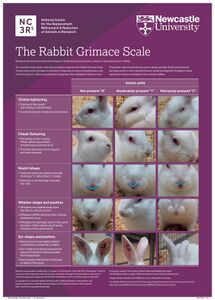
GI symptoms
Gastrointestinal symptoms are usually an emergent situation with rabbits as they need to be eating and processing food constantly to keep their digestive systems working.
- loss of appetite (anorexia) or changes in eating habits - A good way to test this is to offer an irresistible treat to your bunny such as fruit.
- small to no poop or diarrhea - True diarrhea should not be confused with smashed cecals.
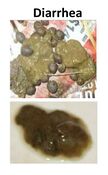
- sitting in a hunched position or pressing stomach against the floor
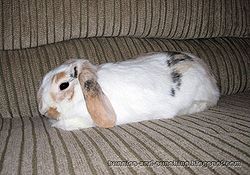
- loud continuous GI sounds or complete silence in the stomach - You can use a stethoscope or listen with your ear pressed against the stomach.
These symptoms are suggestive of an onset of GI stasis, often a secondary symptom to other health issues. As a result, it is important to take your rabbit to an emergency hospital if possible to rule out quickly fatal issues such as (but not limited to) bloat, liver lobe torsion, or gastric ulceration.
Eye symptoms
Most abnormal changes with eyes are an emergency, especially to prevent permanent damage.
- eye discharge and inflammation
- squinting and closed eyes
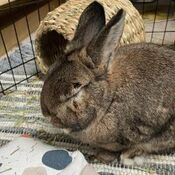 Owner found their rabbit with an eye squeezed shut with mucus. The rabbit persistently tried to paw and scratch at the irritated eye. The rabbit was rushed to an emergency veterinarian, and a large grass seed was removed. The rabbit was placed on pain medication and antibiotic eye drops due to an eye ulcer that had developed.
Owner found their rabbit with an eye squeezed shut with mucus. The rabbit persistently tried to paw and scratch at the irritated eye. The rabbit was rushed to an emergency veterinarian, and a large grass seed was removed. The rabbit was placed on pain medication and antibiotic eye drops due to an eye ulcer that had developed. - cloudy eyes
- protruding and bulging eyes
- exposed third eyelids
These symptoms are suggestive of eye injuries, conjunctivitis, cataracts, dental issues, and other serious issues like thymoma.
Respiratory and ear symptoms
Because rabbits are obligate nasal breathers, meaning they can only breathe through their noses and not their mouths, anything obstructing their ability to intake sufficient oxygen by their noses is an emergent condition.
- increased, shallow, and/or labored breathing (e.g. nasal flaring, heaving sides, wheezing sounds) - For immediate relief, please check their nose for any external physical obstructions like dried mucus and gently clean it off. Increasing the humidity with a humidifier or giving some steam therapy can also ease any congestion.
- chest congestion (may sound like crackling or popping sounds, and a cough may or may not be present)
- tilting head back with the nose lifted upwards without apparent reason (as though looking above towards the sky or ceiling)
These symptoms are suggestive of heat stroke, snuffles, dental issues, or thymoma.
The following are less emergent if your rabbit is otherwise eating and behaving normally, but they should still be seen by a veterinarian soon:
- sneezing, nasal discharge, or watery eyes; matted front paws from wiping nose
- scratching or shaking ears
These symptoms are suggestive of head tilt, otitis, mites, snuffles, or dental issues.
Urinary tract symptoms
- sudden loss of litter box habits
- dribbling of urine (urinary incontinence)
- straining to urinate; sitting in litter box for long periods of time.
- urine as thick as toothpaste (color may vary)
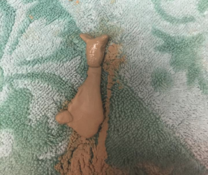
- streaks of blood in their urine
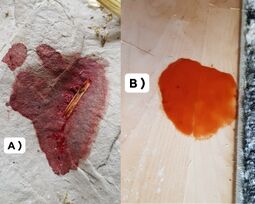
These symptoms are suggestive of bladder sludge and stones, E. cuniculi, urinary tract infection, or uterine cancer in females.
General symptoms
- fever or hypothermia - normal rabbit temperatures are 101-103°F / 38-39.6°C
- loud teeth grinding - a sign of pain, different than gentle tooth purring
- irritability or unusual aggression
- listlessness, lethargy, or lack of interest in surroundings
Extreme emergencies
If your rabbit shows any of the following symptoms, consider it an extreme emergency, and locate an emergency veterinarian immediately.[1]
- shallow breathing and/or weak heartbeat
- complete immobility or unresponsiveness
- severe diarrhea or mucous-covered stools
- complete silence in stomach - this is a sign of full stasis
- very labored breathing (e.g. head tilted up, bobbing head) - See #Respiratory and ear symptoms in the section above for additional video examples.
- convulsions or seizures
- any injury resulting in open wounds or possible broken bones - this includes any sort of attack by another animal. If your rabbit is limping or dragging limbs, please immediately put your rabbit on cage rest to prevent further damage until they can be seen by a veterinarian.
- any symptoms of shock - listlessness, limpness, or abnormal gum coloring (grayer or redder than normal).
- temperatures lower than 100°F/37.7°C or higher than 104°F/40°C (hypothermia)
- not eating for 12 hours, no poop in 12 hours, or increasingly smaller poop
- dehydration - dry tacky mucous membranes and/or delayed skin elasticity
- gray, mauve, or white mucous membrane color (e.g. check gums and eyelids) - this is a sign of severe anemia or lack of oxygen (hypoxia).
- loss of balance or head tilt
- partial or total paralysis
How can I keep my rabbit stable until a veterinarian is available?
The following are a list of checks to go down from most important to less important, and many are also duplicated from our GI stasis#At-home treatment section:
- Is my rabbit bleeding? If your rabbit has an open wound, make sure the wound has stopped bleeding. If it is not clotting on its own, use a sterile gauze to apply constant and firm pressure. If the bleeding has not stopped after 5 minutes, please proceed to an emergency veterinarian immediately for a positive prognosis.
See First aid for rabbits#Wound care for more tips on how to treat wounds at home.
- Is my rabbit warm? Hypothermia is one of the biggest killers of rabbits. Use a rectal thermometer to check your rabbit's temperature - it should be between 101-104°F (38.3-40°C).
A temperature below 100°F means the rabbit is starting to go into or is already in shock. Rabbits will be very lethargic with decreased responsiveness to stimuli. If you do not have a thermometer on hand, if your rabbit is already lethargic and their ear tips and limbs feel cold, they are likely hypothermic. Immediately start warming up your rabbit with heat support. A heating pad, a plastic bottle full of hot water, a microwaved sock full of rice, or a SnuggleSafe disc should be wrapped in a towel to prevent burns. If you do not have any heating accessories, you can microwave a towel or blanket for 30 seconds to temporarily heat it up, or just wrap your rabbit completely in a towel or blanket. Portable hand warmers are also extremely useful under towels and blankets and should be moved around the body every 5-10 minutes to warm them up. Note that rabbits that were hypothermic when taken to the veterinarian for initial stasis treatment have been studied to be 5 times as likely to die or be euthanized compared to rabbits that were of normal body temperature.[2]
A very high temperature above 106°F also needs immediate attention. You can cool down your rabbit by putting the rabbit in a breezy area and carefully wetting down the ears, their main thermoregulatory organ.
- Is my rabbit hydrated? You can use the skin tent test to check if your rabbit is well hydrated.
Ideally, if your rabbit is visibly dehydrated, warmed subcutaneous fluids are a great first aid. You should have received a dosage from your veterinarian when you purchased the supplies. Refrain from force feeding any water directly with a large syringe as liquids are easy for rabbits to aspirate and cause more serious issues. If you do not have subcutaneous liquids on hand, giving liquids carefully with a small 1-3 ml syringe. Offer 10-20 ml of liquids slowly orally.
- Can my rabbit breathe easily? See #Respiratory and ear symptoms for example videos of these symptoms. If your rabbit is in respiratory distress, for immediate relief, please check their nose for any external physical obstructions like dried mucus and gently clean it off. Increasing the humidity with a humidifier or giving some steam therapy (e.g. sitting with them in a steamy bathroom) can also help ease any congestion. If you have received instructions about nebulizing your rabbit, it may be a good idea to do so with saline.
If you have a rabbit in respiratory distress, it may be a good idea to find any emergency veterinarian within driving distance to get oxygen support as soon as possible because rabbit are obligate nasal breathers, meaning they can only breathe through their noses and not their mouths. Rabbits that are already breathing through their mouths for air have a very poor prognosis.
- Is my rabbit getting bloated? Bloated rabbit stomachs will feel like an overfilled balloon and become visibly distended. If your rabbit is bloated, please find your nearest emergency veterinary hospital and start treatment promptly for the best chance of recovery. Keep your rabbit warm and hydrated in the meantime to the best of your ability.
- Is my rabbit anemic? You can check their gums or flip over their eyelid to check their mucusa is a shade of pink. Rabbits can become anemic from both external and internal bleeding. If the mucusa looks white, grey, or mauve, you should seek any kind of emergency medical help as soon as possible as there is not much that can be done for the condition at home, especially if the bleeding is internal. Keep your rabbit warm and hydrated in the meantime to the best of your ability.
- Is my rabbit eating well on their own? If your rabbit is showing signs of pickiness, give them whatever food (except treats) they are willing to eat in larger amounts until you can see your veterinarian.
If your rabbit has refused to eat anything in over 8 hours or only eating vegetables and shows no signs of bloating, assist feed 10-20 ml (1 dry Tbsp) of Critical Care, pellet mash, or pumpkin puree to make sure there is food and fiber in their system for calories and to encourage digestive movement until you can reach a rabbit-experienced veterinarian for diagnosis and treatment. If you are unsure if your rabbit is bloated, it is best to avoid adding more food in the stomach and find your closest veterinary clinic as soon as possible. Syringe feeding with a bloated stomach can make the issue worse and rupture their stomach from the pressure.
- Can my rabbit hop around easily? If your rabbit is showing signs of head tilt, limping, or other abnormal and unsteady behavior, it is best to put them on cage rest to prevent further injuries. For rabbits that are struggling to move at all, a small carrier would be a good containment area until they can see a rabbit-experienced veterinarian.
While pain control is important for rabbits and their recovery when feeling unwell, we are hesitant to recommend any specific at-home drug treatments to help keep your rabbit stable unless you have direct instructions from your rabbit-experienced veterinarian about usage scenarios and dosages. Many conditions such as kidney disease and gastric ulcers can be dangerously exacerbated if rabbits are given NSAIDs such as meloxicam indiscriminately, especially if dehydrated.
How to prepare for a visit to an emergency center
To assist the emergency veterinarian, it is helpful to know some things about the rabbit concerned. The following list is paraphrased from Rabbit Advocates and other sources:[3]
- A history of illness, including symptoms.
- Treatments given and any reactions.
- Baseline lab work (blood and urine) - obtainable from your regular veterinarian.
- Current normal weight.
- Complete diet including date of when new foods were started and any reactions.
- Normal food and water consumption.
- Normal urine and stool output.
- Neutering status.
- Vaccination status (if relevant).
Here are some more resources about preparing for an emergency visit.
- Kathy Smith, Planning for Emergencies
Further reading
- Dawson, B. (2011). Dealing with Medical Emergencies
- Zooh Corner. (2014). Rabbit Medical Emergencies
- Happy Hoppers Rabbit Forum. (2008). Emergencies: When Your Rabbit Needs A Vet NOW
- Lathan, L. First Aid For Rabbits
- Petfinder. Help! My rabbit is sick and I can't reach my vet!
- Paul-Murphy, J. Emergency Medicine and Critical Care for Rabbits
- Rabbit Welfare Association & Fund. (2005). Rabbit ER : When your rabbit needs to see the vet NOW
- Rabbitwise, Inc. Rabbit 911
See also
References
- ↑ Smith, K. (2003). Rabbit Health in the 21st Century. (2nd ed.).
- ↑ Kimberly M Oparil et al. (2019). Clinical characteristics and short-term outcomes for rabbits with signs of gastrointestinal tract dysfunction: 117 cases (2014-2016). Retrieved 27 Feb 2023 from https://www.researchgate.net/publication/336181390_Clinical_characteristics_and_short-term_outcomes_for_rabbits_with_signs_of_gastrointestinal_tract_dysfunction_117_cases_2014-2016
- ↑ Rabbit Advocates. (2000). Useful Tips for a Trip to the Emergency Center. Retrieved 07 Feb 2017 from http://rabbitadvocates.org/careinfo/packet/emer.html


